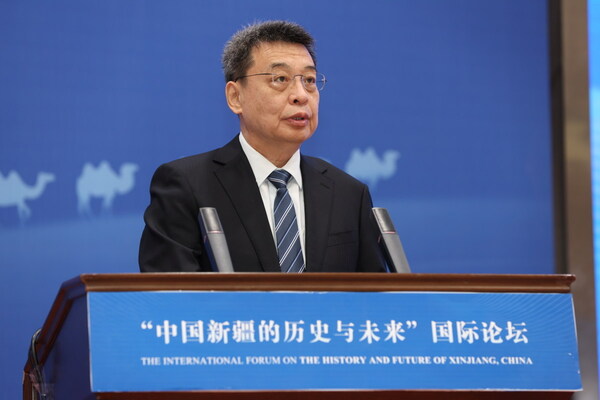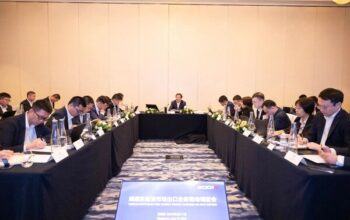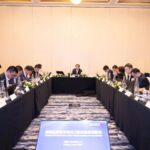BEIJING, June 12, 2024 /PRNewswire/ — A news report from chinadaily.com.cn:

Pan Yue, director of the National Ethnic Affairs Commission, delivers a keynote speech at the International Forum on the History and Future of Xinjiang in Kashgar, Xinjiang on Wednesday. Jiang Dong/China Daily
— Speech at the International Forum on the History and Future of Xinjiang, China
Pan Yue
June 12, 2024
Honorable Chairman Erkin,
Honorable Mr Ambassador Nuryshev,
Distinguished experts and friends, good morning!
The international forum “The History and Future of Xinjiang, China” is being held in the renowned ancient Silk Road city of Kashi (aka, Kashgar). On behalf of the National Ethnic Affairs Commission, I would like to offer my warm welcome to everyone.
As President Xi pointed out: “We advocate the respect for the diversity of civilizations. Countries need to uphold the principles of equality, mutual learning, dialogue and inclusiveness among civilizations, and let cultural exchanges transcend estrangement, mutual learning transcend clashes, and coexistence transcend feelings of superiority”. Today, among us are old friends and new from various countries, as well as many scholars from China, many of whom are respected authorities in their respective fields, such as history, archaeology, anthropology, and environmental science. One of the reasons that brings us together here is the excavation and research of the Mo’er Temple archaeological site by Minzu University of China, under the National Ethnic Affairs Commission. It provides us another good example of integration of diverse civilizations.
Xinjiang boasts a rich tradition and coexistence of diverse cultures and religions. In addition to numerous Buddhist sites, a Zoroastrian fire altar from 2500 years ago was found in Tashkurgan county; In the ancient city of Milan in Ruoqiang county, a Greek-style “winged angel” Buddhism mural from 1800 years ago was uncovered; Taoist scriptures and the Christian Bible were unearthed together from a 1300-year-old Nestorian monastery in Turpan; Manichaean worship scenes from 1000 years ago were discovered in the murals of the ancient city of Gaochang in Turpan; In the ancient city known as Dun ancient city of Tang Dynasty, in Qitai county, a Nestorian church from 1200 year ago was found, whose murals depict the scene of Jesus entering Jerusalem on a donkey. Inside the city, an ancient Roman-style bathhouse from 1000 years ago was also excavated. These ancient cultures, together with Islamic culture later, have merged into the rich religious culture of Xinjiang.
Culture of Xinjiang is diverse, but more in unity. That the unifying element is “Chinese culture”.
Internationally, there is a baseless narrative that separates Xinjiang culture and Chinese culture and even portrays them as being in opposition. However, a large amount of archaeological evidence tells us that Xinjiang has always been an important part of the Chinese cultural sphere. During the Neolithic period, the painted pottery culture from the Yellow River Basin had already spread to the northern and southern regions of the Tianshan Mountains through what are today Gansu and Qinghai provinces. Jade is a unique Chinese cultural symbol, representing national power and ritual ceremonies, and Hetian jade from Xinjiang has been found at cultural sites in Yangshao, Longshan, Qijia, Yinxu, and other places in the Central Plains. Before the Han Dynasty exercised jurisdiction over Xinjiang two thousand years ago, the myth of the Queen Mother of the West of Kunlun Mountain in Xinjiang had long been a core part of the Chinese mythological system. Moreover, the vast amount of Confucian cultural relics unearthed in Xinjiang from the Han (202 B.C-220 A.D), Jin (266-420), Southern and Northern Dynasties (420-589), Tang (618-907), Song (960-1279), and Yuan (1271-1368) dynasties, such as the ancient city of Loulan in southern Xinjiang, the Niya site, and the Astana tombs in Turpan, including remnants of Confucian classics like the Book of Songs, the Book of Documents, the Spring and Autumn Annals, Zuo Zhuan, the Analects, the Book of Rites, and the Classic of Filial Piety, all reflect the historical fact that Chinese culture has flourished in Xinjiang. The previously mentioned diverse cultures introduced from all directions that were able to develop here further testify to the inclusiveness of Chinese culture from another perspective. Confucian culture is humanistic rather than religious, without exclusivity, and can accommodate the coexistence and development of multiple religions. The more inclusive and open it is, the more it is recognized, cherished, and maintained by all parties, ensuring the continuous and unbroken heritage of Chinese civilization to this day.
There is an internationally prevalent narrative that untruthfully portrays the relationship between Xinjiang culture and Chinese culture as being the “assimilation” of the former by the latter. This reflects the widespread ignorance of Chinese history. Peoples of the Western Regions have always been co-creators of Chinese culture. For instance, Nong Sang Cuo Yao, the ancient treatise on agriculture and sericulture, was compiled by the Gaochang agronomist Lu Mingshan, a Uyghur ethnic in the Yuan Dynasty (1271-1368). Many important texts in Chinese Buddhism, such as the Diamond Sutra, were translated by the Kuchean monk Kumārajīva. He introduced terms such as “compassion”, “world”, “enlightenment”, “sea of suffering”, and “river of love”, which are terms adopted by modern Chinese. Additionally, during the Yuan Dynasty, Lian Xixian also a Uyghur ethnic served as chancellor under Kublai Khan and was a master of Confucianism who greatly promoted Chinese culture. The Weigongcun area in Beijing, renowned for its cluster of prestigious universities, derives its name from the Lian Xixian’s title, Duke of Wei, a name that persists to this day.
Chinese culture and the Chinese nation have been continuously inherited and developed over generations. The Yuan Dynasty (1271-1368), which replaced the Song Dynasty (960-1279), compiled the Song’s history, just as Ming Dynasty (1368-1644), which succeeded the Yuan, compiled the Yuan’s history, and the Qing Dynasty (1644-1911), which succeeded the Ming, compiled the Ming’s history. Notably, Kanglinaonao, a Mongolian ethnic from the Western Regions, played a significant role in reinstating the imperial examination system and compiling the history of the Song Dynasty during the Yuan Dynasty. The culture of Chinese Nation Community is a collective creation and inheritance of various ethnic groups, including those from the Western Regions.
The foundation of a cultural community is the deep integration of the economy and society. The geographical layout of the Pamir Plateau and the Hexi Corridor has been a significant factor in the economic integration of the Western Regions with the East. The economic structures of the Western Regions and the Central Plains are complementary and interdependent. It was the high degree of connectivity between the Western Regions and the vast market of the Central Plains that enabled the Western Regions to facilitate communication across the Eurasian continent. The ancient Silk Road, jointly opened up by ancestors of the Western Regions and the Central Plains, led to the rise of numerous trading cities, with Kashgar being a prominent jewel among them. Over several thousand years, people from all directions and ethnic groups migrated, settled, traded, intermarried, and formed a coexistence pattern in Xinjiang. Ultimately, Xinjiang and the Central Plains belonged to the same political community, which was the inevitable result of the development of economic, social, and cultural communities.
Some foreign friends are concerned that if Xinjiang is considered an integral part of the Chinese civilization, it might lose its cultural identity. According to Western “pluralism”, diversity and unity are often seen as contradictory. However, Chinese philosophy always dialectically unifies diversity and unity, even merging seemingly contradictory elements, such as the Integration between Confucianism, Buddhism, and Taoism, an important academic phenomenon that President Xi Jinping has mentioned. When early Buddhism was introduced to the Central Plains through Xinjiang, its teachings, which discouraged productivity, ancestor worship, filial piety and reverence for rulers, clashed with Confucian and Taoist thought. However, Buddhism integrated the Confucian ethics of loyalty and filial piety, reconciled the concepts of karma and filial duties, and adopted Taoist meditative practices, forming sinicized Buddhism. Meanwhile, Confucianism absorbed Buddhist philosophical concepts, developing Neo-Confucianism.
Today, Confucianism, Buddhism, and Taoism have not merged into a single entity. Instead, they have intermingled, creating a broader spiritual community for the Chinese people, one that embodies unity in diversity. The unity fosters diversity, and the diversity enriches the unity, as exemplified by Mo’er Temple. This small site in Kashgar, with a history spanning at least 700 years, contains an Indian Gandhara-style Buddhiststupa, a Central Asian and Xinjiang native square-shaped temple, and a Chinese Buddhist grand hall. It reflects early Indian Buddhism evolved into a Western Regions variant in the Tarim Basin before spreading east to the Central Plains. Centuries later, sinicized Buddhism returned to the Western Regions, building Chinese Buddhist halls at its original entry points into China.
Islam entered China with similar experience. One route was through Maritime Silk Road to Quanzhou, the other was through Overland Silk Road to Xinjiang and led to religious conflicts with local faith of Buddhism. Many traces of this part of history can be found in Buddhism ruins in southern Xinjiang. However, ultimately, Islam, after its entry into China, began integrating with Confucian, Taoist, and even Buddhist philosophies during the late Ming and early Qing dynasties, resulting in the thought of “integration of Islam and Confucianism”. Chinese translators of Islamic scripture then especially proposed the dual loyalty of “respecting Allah and being loyal to the state”, highlighting the commonality of Islamic and Confucian ethics. The Shaanxi Grand Mosque in Urumqi, built during the Qianlong reign (1736-1796) of the Qing Dynasty (1644-1911), exemplifies the architectural style of the integration of Islam and Confucianism. The spirit of this integration,overlapping with the rational thinking in Islamic world, becomes an important attempt to coordinate the relations between national and ethnic identity, religious doctrine and secular life. Malaysia recently hosted a conference on the integration of Islam and Confucianism, where Prime Minister Anwar Ibrahim stated, “by focusing on the points of convergence between Islam and Confucianism, we are actively choosing to diverge from the path of discord”. His excellency also mentioned, “by embracing the wisdom of Islam and Confucianism, we can work towards a future that is not only technologically advanced but also morally enlightened”. The spirit of integration between Islam and Confucianism continues to nourish Xinjiang today.
Whether Buddhism or Islam, on entering China, both underwent collisions and integrations, evolving into Sinicized Buddhism and Sinicized Islam. This process of collision and integration was not aimed at eliminating each other but at enhancing each other, resulting in the emergence of more inclusive civilizations. The story of Xinjiang fully demonstrates that Chinese civilization has always remained vibrant through its inclusiveness.
All politicians and scholars around the world who are concerned about China should study President Xi Jinping’s concept of the “second integration” — the integration of Marxism with China’s excellent traditional culture. This integration has produced a profound “chemical reaction”, creating a new, organically unified cultural entity. The integration of Marxism and continuity of the Chinese civilization fundamentally determines that the Chinese path contains an uninterrupted civilizational logic. The integration of Marxism and the innovative nature of Chinese civilization determines that this “integration” is not about reviving the past but about ushering in new ideological liberation.
The integration of Marxism and the unity of Chinese civilization determined that the country’s territory cannot be separated, its stability cannot be disrupted, the nation cannot be divided, and the civilization cannot be interrupted. The integration of Marxism and the inclusiveness of Chinese civilization decided that Chinese civilization has never sought to replace diverse cultures with a single one, but has instead formed a common culture through the convergence of multiple cultures. The integration of Marxism and the peaceful nature of Chinese civilization fundamentally determined that the Chinese civilization in modern times always strives for harmonious coexistence, consistently seeking common ground while reserving differences, and continually pursuing peaceful and mutually beneficial outcomes. The stories of the peaceful coexistence of multiple ethnic groups and diverse religions in Xinjiang illustrate to the world that China, a country that has experienced almost no religious wars for thousands of years, and a country that has never engaged in colonial expansion or forced cultural exportation, may offer another perspective into ethnic and religious conflicts.
Most of the Experts here today are researchers of ancient civilizations, which inherently embodies diversity and seeks unity and cohesion in its own way. Though we may not fully agree with each other’s methods of seeking unity, we all sincerely hope that we can all achieve strength in unity and cohesion. We pursue shared goals, learn from each other, and realize our aspirations in our own ways.
As a place where diverse civilizations converge, both the historical and future Xinjiang will adhere to the path of unity in diversity, building a safer and more harmonious Xinjiang. It will better serve as a hub connecting China with Central Asia, West Asia, and Europe. It will play a stronger supporting role in creating the core area of the Belt and Road initiative. It will also better protect the excellent cultures of various ethnic groups to enrich and develop the splendid and diverse Chinese civilization. Therefore, Xinjiang is not only China’s Xinjiang but also the world’s Xinjiang. It is our shared vision to make Xinjiang, with its past, present and future, reach out to the world.
I wish the forum great success. Thank you.



















